
NCH-49

K.S. Hendrix, Purdue University D.A. Rhoweder, University of Wisconsin
T.J. Klopfenstein, University of Nebraska D. H. Smith, Colorado State University
H. F. White, Virginia Polytechnic Institute & State University
The goal in making corn silage is to efficiently harvest and store the maximum amount of digestible nutrients per unit of land area. This requires that dry matter losses due to harvest and storage be minimized. The end result, high quality silage, is readily consumed by animals and is capable (with proper supplementation) of inducing high levels of animal product.
Excessively wet silage (>70% moisture) usually results in fermentation dominated by undesirable butyric acid-forming bacteria, the loss of large volumes of highly digestible nutrients through seepage, and poor animal performance due to low consumption. On the other hand, overly dry forage is difficult to pack (especially in horizontal silos), resulting in mold and heating.
The ideal moisture concentration (65 to 70%) for ensiling corn closely coincides with the stage of development that ensures near maximum production of total digestible nutrients (TDN)/acre (Fig. 1). Forage to be stored in horizontal silos should be near 70% moisture in order to facilitate tight packing and air exclusion. Most upright silos should be filled with 60 to 66% moisture forage to avoid seepage; however, this will vary somewhat depending on the height and diameter of the silo, since packing is achieved due to the height of the column of forage. Nevertheless, factors such as degree of packing, type of silo, and presence of additives can influence how wet a silage may be stored.
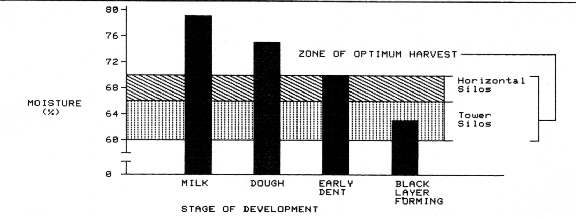
There is a direct relationship between the moisture content of the silage and the amount of seepage produced. For example, based on data from bunker silos collected over many years, it appears that no seepage will occur if silage is less than 71% moisture. In tower silos, 70% moisture corn silage will not seep if silo height does not exceed 40 feet. For each additional 10 feet of silo height, moisture concentration should be decreased by 1% to avoid seepage. In addition to problems with seepage, excessively wet forage (over 70% moisture) may decrease the maximum capacity of the silo because a large amount of water versus dry matter is stored. Maximum silo capacity may also decrease with excessively dry forage (under 50% moisture) due to failure to achieve a tight pack in the silo. If 50% moisture forage is used, the silo capacity has been estimated to decrease by about 25%. The maximum capacity of a tower silo filled with corn silage is achieved when the moisture is between 60 and 65%.
The best way to manage moisture content of corn silage is to harvest at the proper stage of plant development. However, there are some other management practices which help solve unfavorable moisture problems with silage.
One of the most practical ways to reduce seepage from high moisture forage is to add an absorbent to the silage. Ground grain or straw can be used to reduce moisture by 1% for each 30 lb. of dry material applied per ton of silage. Straw is capable of absorbing 3 to 4 lb. of water per lb. of dry matter (DM).
Silage that is harvested too dry can undergo serious storage losses (especially if stored in a horizontal silo) due to failure to exclude air from the silage mass. This allows molding and heating of the forage to take place which may greatly reduce silage quality. In such cases, water can be added to bring moisture concentration to at least 60%. Water uniformly mixed with the forage at roughly 7 gal. of water per ton prior to ensiling will increase the moisture content of silage by about 1%.
Growing several varieties with widely differing maturities (early-mid-full season) will provide flexibility in harvesting at the proper moisture content and extend the "safe" harvest period (Table 1).
Moisture Testing. Using a commercial moisture tester to accurately determine whole plant moisture is the best way to avoid variation in visual estimates of moisture content due to hybrid and season.
There are several forage moisture testers that are commercially available. Some of these units provide almost instantaneous read-out using the relationship between moisture in the sample and electrical conductivity. These units require careful calibration, but are usually accurate to 5% (compared with forced-air or heat drying). Small forced-air units with precalibrated scales are also available. These units are very accurate (to 1%), but require from 25 to 40 minutes to obtain a reading.
The following procedure for determining silage moisture content requires an accurate scale (to 1 gram) and a microwave oven, and takes from 20 to 30 minutes (depending on the particular oven and the amount of moisture in the samples).
Maturity Harvest date
group Aug. 22 Sept 9 Sept 22 Sept. 29
----------------------------------------------------------------------
-----yield, tons at 65% moisture----
Early 22 24 -- --
Mid 20 23 25 --
Full 16 23 25 29
---------% moisture--------
Early 71 60 -- --
Mid 73 63 54 --
Full 76 69 63 60
------------------------------------------------------------------------
Source: NC State University
With experience, you can adjust the time periods and decide whether or not it is necessary to use the glass of water. Usually, the above method will give moisture content that is about 1 to 2% less than the true sample moisture content. Silage samples take 20 to 30 minutes because of coarse particles and grain content which dry slowly.
General Physical Appearance. Because of variation among hybrids, it is wise to use several plant indicators when attempting to visually determine whether corn is ready for the silo. Under normal conditions, plants that are ready for harvest will exhibit some browning of the lower leaves while the upper 3/4 of the plant will be green (Fig. 2); husks will be dried to a tan color (Fig. 3); ears will have fully dented and glazed kernels; and whole plant moisture will be in the range of 60 to 68%.
Drought conditions may require that harvest management be altered to account for abnormal plant development. In drought years, plants will need to be harvested earlier than normal because of higher dry matter content. It is generally true that drought-damaged plants are usually wetter than they appear. Therefore, a preliminary moisture determination should be made before ensiling using a microwave oven or commercial moisture tester.
In addition to the general physical appearance, there are two specific characteristics which have been used to estimate physiological plant maturity and grain moisture concentration. These characteristics, black layer formation and milk line position, are also related to whole plant moisture concentration.
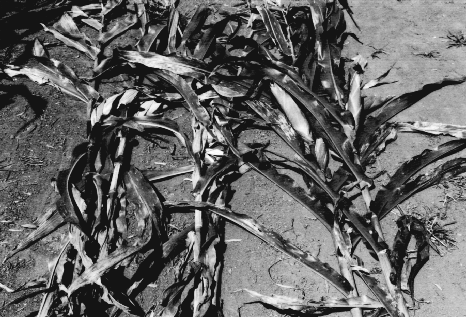
Black Layer Formation. The corn plant continues to increase in dry weight until it is physiologically mature. At maturity, black layer formation occurs when several layers of cells at the tip of the kernel die (Fig. 4). When these cells die, dry matter accumulation ceases. The black layer can be used as an indication to begin harvesting because the onset of black layer and desirable moisture content for ensiling tend to coincide.
Although black layer formation can be a useful indicator of crop maturity, it is sometimes difficult to decide when the layer is truly "black." Variability in the intensity of the black layer can be confusing to the inexperienced observer (Fig. 4). Also, there seems to be some variation in the intensity of the black layer among hybrids.
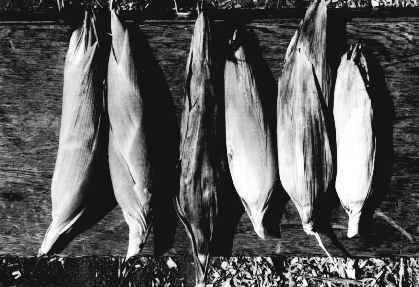
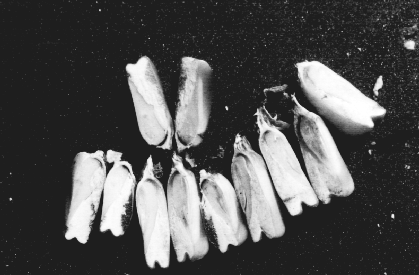
Milk Line. It has been suggested by Minnesota researchers that the milk line may be a useful visual indicator of kernel maturity. If an ear of corn is broken, the tip portion of the ear will show the endosperm face of the kernels. It is here that the milk Fine can be observed. As the plant develops and the kernels mature to the full dent stage, a distinct line can be seen progressing from the kernel crown to the base. The milk line separates the solid from the liquid portion of the kernel. When the milk line is half way between the crown and the tip (half milk stage), kernel moisture is about 40%. At the half milk stage, over 90% of the "normal" yield of grain can be expected. When the milk line has reached the kernel base and becomes indistinct, the kernel base can be probed with a knife point to see if milk remains. Kernels containing no milk are physiologically mature and should contain a fully developed black layer (Fig. 5).
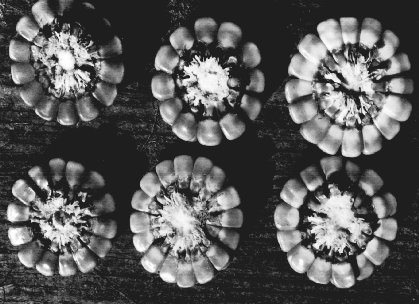
Although observing black layer development and milk line position may aid in estimating whole plant moisture percentage, it is apparent from Table 2 that plants with a fully formed black layer or with little or no milk remaining in the kernel are too dry for optimum silage harvest. In most situations, silage harvest should begin prior to full black layer development after the milk line has descended to about 1/3 of the distance between the kernel crown and base.
Hybrid1 Harvest Black layer2 Milk line Whole plant
date development position3 moisture %
-----------------------------------------------------------------------
Early Sept. 6 1.3 .30 64
Mid 0.8 .15 68
Full 0.4 .03 71
Early Sept. 25 2.1 .80 57
Mid 1.7 .65 60
Full 1.4 .38 67
Early Oct. 3
Mid 2.7 .98 57
Full 2.1 .60 63
Early Oct.16 ---
Mid
Full 2.7 .83 61
-----------------------------------------------------------------------
Source: North Carolina State University
1 Early-Season= Pioneer 3389, Mid-Season = NK PX79, Full-Season =
DeKalb 394.
2 Black Layer Index: 0 = no sign of black layer, 1 = layer
darkening. 2 = layer brown, 3 = layer black.
3 Milk Line Position: .5 = milk line at kernel mid-point (1/2 milk
stage), 1 = milk line descended to kernel base, no longer visible.
One of the most important harvest management considerations involves adjusting the particle size of the chopped forage to ensure a tight pack so that air is excluded from the silage mass. Particle size can be manipulated through machine adjustments involving the knives and shear bar on the silage harvester. Knives should always be kept sharp during harvesting. Michigan State University workers have suggested that 1/4 to 3/8 inch theoretical length of cut is near ideal for minimizing storage losses. Extremely fine chopped corn silage (1/8 inch or less), such as that produced by using a recutter screen, is undesirable. Such fine chopped material is known to reduce milk fat test with dairy cows due to a decrease in "effective" fiber in the ration. A practical rule of thumb is that most of the silage particles should be about 1/2 inch long, with 15 to 20% of the particles being 1 inch in length. If the silage is too dry, i.e., below 60% moisture, the chop length should be reduced to near 1/4 inch so that the silage can be adequately packed. Reducing length of cut in this situation, however, will increase the power requirement and may slow harvesting.
Rapid filling, tight packing, and proper sealing are essential in order to exclude air from the silage mass. These three important tasks represent the last management opportunities before the actual ensiling process beings.
Untimely delays during silage harvest can be costly because such delays almost always favor undesirable fermentation leading to dry matter losses and reduced feed quality of the resulting silage. Silo size and/or fill capability should be such that a given silo can be filled in 1 to 3 days. Delaying from a one-day to a five-day fill rate has resulted in as much as a 50% reduction in lactic acid concentration and a two-fold increase in fermentation-associated dry matter loss of the silage.
Freshly cut forage must be physically packed into horizontal silos with tractors, trucks, or other equipment. Packing is needed between each load of silage. When the silo is full it should immediately be crowned in the center to shed water and be covered and sealed with 6 mil polyethylene.
To maintain a tight seal during storage, old tires or about 4 inches of saw dust should be placed on top of the plastic cover.
Silage making is a complex system requiring simultaneous use of separate machines, teamwork of several workers, and considerable fuel.
New technologies on the horizon center on 1) design of machines for silage chopping, transport, and handling to improve energy efficiency and 2) manipulation of silage making with additives of various types to increase energy density and digestibility of feed per unit volume of material handled, stored, and fed.
Silage making involves separate machines for chopping, transporting, and handling materials and filling and unloading the silo. All machines except that for silo unloading are usually powered by diesel engines. When chopping, the power requirement increases directly with harvesting rate (tons/hour) and with decreasing length of cut. Moisture content has some influence on the energy requirement for chopping, but within the normal silage range the variations are small. Some crops are more easily chopped than others. For example, at a given length of cut corn requires about 70% of the energy needed to chop many grass and legume silages.
Increasing corn silage cut length from 1/4 to 1/8 inch may drop the energy required by 15%. At a particular cut length setting, a chopper produces a range of particle lengths. At 3/8 inch theoretical cut length, the actual average forage particle length is usually about 1/2 inch. However, too many long particles can create problems with silage unloading and mechanical feed equipment. Shorter cut lengths and improved energy efficiency for silage chopping are conflicting factors. Currently, adequate fuel supplies favor short cut lengths and thus ease in mechanical handling.
The daily labor and fuel needs for selected silage production systems are summarized in Tables 3 and 4. These comparisons indicate the potential labor and fuel savings by using alternative silage transport methods. These data indicate the intensity of labor and fuel use during a typical day of silage harvesting. Slightly more than 1/2 of all fuel used for silage making is required for chopping. Labor for chopping is about 1/4 of the total labor. Transporting and handling silage requires 1/2 of the total fuel and 3/4 of the labor when transport distance from field to storage is one mile.
The labor requirements for transporting corn silage to tower silos in self-unloading wagons, one load at a time, exceed that of chopping by a factor of four (Table 3).
Silage and
storage system Output Chopping Transport* Store Time
-----------------------------------------------------------------------
tons/day --man-hours---- min./ton
Corn (tower) 150-200 4 16 3 9
Corn (bunker) 150-200 4 9 4 7
-----------------------------------------------------------------------
Source: Penn State University
* Transport systems were: Self-unloading wagons (tower) and dump trucks
(bunker).
Dump trucks reduce the transport labor by 44% compared with self-unloading wagons. Trucks also reduce fuel used in transport by similar amounts (Table 4).
Silage and
storage system Output Chopping Transport* Store Amount
--------------------------------------------------------------------------
tons/day ---gal./day---- gal/ton
Corn (tower) 150-200 35 27 13 .4
Corn (bunker) 150-200 35 11 13 .3
--------------------------------------------------------------------------
Source: Penn State University
*Transport systems were: Self-unloading wagons (tower) and dump trucks (bunker).
Tractor size for chopping depends mainly upon harvesting rate (tons/hr.), which, in turn, depends upon the capacity or width of the chopper. Generally, the tractor power ranges in Table 5 are recommended.
Rows Horsepower ------------------------------------------ One 40-80 Two 80-120 Three or more 120 and up ------------------------------------------
Fuel and labor inputs must be distributed over the remaining dry matter (DM) base when DM loss occurs during harvesting, storing, or feeding. This increases input per unit residual DM. For example, a 20% DM loss in storage increases the fuel and labor investment per ton of residual DM by 25%. Conserving DM throughout the system conserves both fuel and labor and provides a greater feed return per unit of input.
Typical DM losses for various forage harvesting systems are shown in Table 6. The small overall DM loss for the corn silage system helps to maintain efficient returns on fuel and labor inputs.
System Mow/cure Harvest Storage Feed Total loss ------------------------------------------------------------------------ Corn silage -- 5 6 4 14 Grass silage 6 5 6 11 24 Baled hay* 10 3 4 5 20 Round bales** 10 10 12 14 39 ----------------------------------------------------------------------- Source: Penn State University *Stored outside for 6 months and fence-line fed. ** No rain damage.
When the harvesting inputs of fuel and labor are distributed over the DM actually used as feed, then systems can be compared (Table 7).
The general comparison between silage and hay indicates that silage systems require twice as much fuel per ton of feed DM as hay systems and 1/2 of the labor. A major portion of operating costs can be estimated from Table 7 by using a wage rate per hour and fuel cost per gallon. Machinery repair, twine, etc., costs should be added for a more precise economic analysis. For example, if labor costs are estimated at $5 per hour and diesel fuel $1.20 per gallon, then operating cost estimates (without repairs) for the system are those listed in the Total Cost column.
With current technology, silage systems do not offer both reduced labor and low fuel inputs. Silage making has a low labor but high fuel input. Hay systems tend to be the opposite. The operating costs indicated in Table 7 are insufficient as a basis for selecting one system over another. They simply reflect the range of costs assigned to labor and fuel in forage harvesting which are major factors of total costs.
In silage systems, a disproportionate share of both labor and fuel goes into transport when traditional tractor-wagon combinations are used. New designs for transport machines can help solve this problem and further reduce labor and fuel costs for silage making.
Labor Fuel Total
Systems Time cost Amount Cost cost
--------------------------------------------------------------------
-----per ton of DM --------
hr. $ gal. $ $
Silage, tower silos, SUW, 1.1 5.50 2.1 2.50 8.00
unloader, feed bunk
Silage, bunker silos, trucks 0.8 4.00 1.7 2.00 6.00
feed wagon, and bunk
Hay bales, manually loaded 2.0 10.00 0.7 0.80 10.80
self-feed rack, inside
storage
Round bales, transporter 1.6 8.00 1.4 1.20 9.20
outside storage (6 mo.),
fence line feeder
---------------------------------------------------------------------
Source: Penn State University
*Self-unloading wagon.
New 1/87
Cooperative Extension Work in Agriculture and Home Economics, State of Indiana, Purdue University and U.S. Department of Agriculture Cooperating. H.A. Wadsworth, Director, West Lafayette, IN. Issued in furtherance of the Acts of May 8 and June 30, 1914. It is the policy of the Cooperative Extension Service of Purdue University that all persons shall have equal opportunity and access to our programs and facilities.